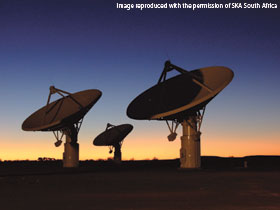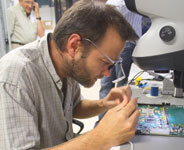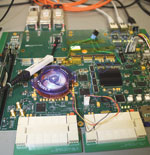

With momentum building on the SKA (Square Kilometre Array) project, Dataweek spoke to SKA South Africa’s Digital Backend Subsystem manager, Francois Kapp, about the impact the project will have on the local electronics industry.
Briefly, the SKA project entails the construction of the world’s fastest, largest and most powerful telescope. This telescope, when completed in 2024, will then spend the subsequent 30 years gathering data from billions of years into the past. In addition to the magnitude of the SKA telescope, what sets this project apart from other telescopes is that it will utilise radio waves, rather than light waves, to form images.
South Africa was awarded the lion’s share (66%) of the project, with Australia receiving the remaining portion. Selection of each country is based on a number of factors, including, predominantly, the ideal geographical features required for optimal transmission of radio waves and collection of data.
In essence, both the dish array and the dense aperture array portion of the contract will be completed in South Africa by an international team of engineers, designers and suppliers; with the sparse aperture array being constructed in Australia. The South African SKA project is funded by the Department of Science and Technology via the National Research Foundation.
The SKA radio telescope will collect radio waves from objects located billions of light years away from the Earth. In order to derive meaningful images from these radio waves, computer technology, which is currently still being developed, will process the data.
The data derived from the project will, amongst other science goals, enable radio astronomers to understand how galaxies and stars formed and how they evolved over time. The goal is to attempt to derive images from the period in time, known as the Dark Ages, leading up to the Epoch of Reionisation, when the first stars and galaxies came into existence.
Putting it together
The SKA comprises three different technologies – a dish array consisting of around 3000 dishes of 15-metres in diameter; a dense aperture array consisting of multiple stations, each containing thousands of densely packed dipole antennas; and the low-frequency (or sparse) aperture array, which consists of distributed dipole antennas.
The preparatory phase of the project is complete and the pre-construction phase, which extends to 2016, has just commenced. The preliminary work packages for this phase have been published and the key Radio Astronomy Research Institutions in the member countries are busy forming consortia that will bid to perform these work packages.

Kapp explained that an SKA board meeting, at the end of January 2013 (after this article went to print), will further clarify the detailed publication of proposal requests for consortia to participate in the pre-construction phase. Once bids are received, the Office of the SKA Organisation will adjudicate them and award work packages to the consortia who present the best proposals.
“The SKA project has introduced a rather interesting concept which revolves around each design partner self-funding their work package. While there may not be any remuneration involved, participation in this phase will have far-reaching effects on future participation and of course there is the prestige and the passion to get the project going, so there are many applicants,” he added.
The pre-construction phase includes the architectural design of the telescopes and their components (dishes and antennas), resulting in a set of validated specifications for all telescope elements. Kapp added that, “By its very nature, this phase of the project is dominated by research and academic institutions.”
Following the design phase, the SKA will publish the specifications for the first construction phase and contracting for the construction and implementation of the telescope will commence.
The engineering contributions are subject to the terms of the hosting and membership agreements, and will also be affected by the funding models. “We are currently negotiating these elements, with some developments being funded by the central SKA project and others being self-funded by the aforementioned consortia. Obviously, these factors will influence the source of each bespoke engineering package,” said Kapp.
Payback time
South Africa is already seeing some benefits of the SKA Project. “SKA South Africa also has a very large human development programme which is well established. In addition to the more than 100 people we employ locally, more than 400 people are studying or have completed Masters and PhD degrees in science and engineering supported by bursaries through the scheme.

“There will also be spin-offs in terms of contracting opportunities in the development of the telescopes. As far as possible, we are trying to bring local companies into the equation. The involvement will not stop with the construction however. There will be an ongoing need, over the final 30 years of the project, for maintenance and upgrades, spanning the full 3000 km area servicing the antennas,” added Kapp.
In addition to the cost of the construction of the array, other major costs will include the development of the very large infrastructure required for the project. The current budgeted amount for the entire project is between 1,5 and 2 billion Euros, with 20% of this being allocated to electronics and signal processing. “However, we anticipate that these ratios will change once the work packages have been agreed on and we gain a more comprehensive understanding of the exact electronics and signal processing requirements,” Kapp continued.
Kapp said that the local SKA project will utilise commercial-off-the-shelf (COTS) electronic equipment where it is available and suitable. “However, there will be areas, such as in the signal processing, where we will be unable to use COTS equipment, due to the extreme data rates and severe radio frequency interference requirements, for instance. In these cases, we will require products to be custom built. The technology we need is currently still emerging and we are carefully tracking its development.”
Facing the challenges
Kapp said that there are three predominant challenges for the SKA project. The first issue is the enormous processing capacity required. “This needs to be developed and is based on computing on the Exa-FLOP scale. The second challenge is the storage capacity of 10-100 petabytes per hour required for the ongoing gathering of data over the 30 years of the operational phase of the project.
“Finally, the construction of the antennas will be undertaken in rather remote areas, with distances spanning up to 3000 km. The logistics of construction and maintenance are immense. The design of the components therefore needs to be focused on reliability and availability,” he added.
There is little doubt that the SKA South Africa project presents the local South African electronics industry with an opportunity to be part of this esteemed venture. “The project will need vast investment in intellectual property in the developmental phases and thereafter; both bespoke and customised products will be used. This will allow any technology developed specifically for this project to be adapted for use in other future technology-based projects. The project allows engineers and scientists to test the boundaries of their current capabilities and challenges them to strive for even greater levels of engineering excellence,” Kapp concluded.
MeerKAT – laying the foundations
The oft-asked question is whether the South African MeerKAT project is the same as the SKA project. The MeerKAT telescope is actually an SKA precursor or ‘pathfinder’ telescope. Funded by South Africa, the array will eventually be integrated into the SKA. Once completed in 2016, this array will comprise 64 antennas and form 25% of the Phase 1 dish array in South Africa.

The MeerKAT will undoubtedly lay claim to being the most powerful radio telescope in the southern hemisphere. Known as KAT-7, seven dishes in the MeerKAT array have been completed as an engineering prototype. These are the world’s first radio telescope dishes made from composite materials (fibre glass) and have already successfully produced scientific images. This data will be utilised by scientists as part of their research work.
Antenna positioners a critical element in SKA project

Alan Geldenhuys, executive director and account manager for the SKA (MeerKAT) Project at Stratosat Datacom, told Dataweek that the company was perfectly positioned to provide the SKA’s precursor project with the technology required for the MeerKAT telescopes.
The company was formed 10 years ago and has spent the last four years making inroads into the astronomy field. “We were awarded a contract in 2009 to replace the seized bearing on the HartRAO 26-metre radio telescope. The repair was successfully completed and the telescope is back in operation. This exposure and experience meant that we were able to comfortably tender for the SKA project.
“Based on our technical proposal, upliftment and empowerment commitments, coupled with our bid price, we were awarded the R630 million contract. This comprises the design, manufacture and installation of 64 Gregorian Offset Radio Frequency Telescopes (13,5 metre diameter) at the SKA site, outside Carnavon in the Karoo,” Geldenhuys explained.
Stratosat Datacom, together with its technology partner General Dynamics C4 Satcom Systems, has provided SKA South Africa with the ultimate technical answer to the stringent requirements defined by the MeerKAT project office. “GDSATCOM has vast and extensive experience in large radio telescope and telecommunications projects around the world. Stratosat Datacom imports, supplies and installs large-aperture satellite dishes for commercial and military applications throughout Africa, with blue chip clients like Multichoice and Vodacom featuring in its portfolio,” added Geldenhuys.
The tender proposal was characterised by tight deadlines and the contract was awarded to the company exhibiting a strong technical base with the lowest bid price. “It was critical to ensure that the design was well thought out and solid in its approach. This was necessary to provide assurance that the technology and hardware would be sustainable for the lifespan of the project,” he continued.
Geldenhuys pointed out that a material feature of the contract, as required by the Department of Trade and Industry (DTI) and the National Research Foundation, was the guarantee that there would be a high level of local content. “At least 75% of the contract value will be spent in South Africa. This includes qualification, testing, tooling design and manufacture. Strong emphasis during the execution of the contract will be to maximise skills and technology transfer to South African based companies. SKA (SA) will take ownership of all project-related intellectual property after the completion of MeerKAT.
“We are hopeful that the imminent success of the MeerKAT project will place us in a favourable position to apply our technology and experience to the remainder of the SKA South Africa project,” Geldenhuys concluded.

© Technews Publishing (Pty) Ltd | All Rights Reserved